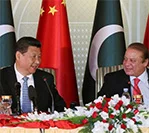For analysts who have been watching developments in South and Central Asia, the recent announcement of the Pakistan-China cooperation agreement was perhaps the biggest news in a century. Coming as it does at a time when Pakistan is grappling with the security problem of insurgencies of different kinds -in Baluchistan as well as the border zone between Pakistan and Afghanistan, the prospect of development aid, to “the tune of US$46 billion (RM161 billion), must be welcomed news indeed.
Notwithstanding the fact that this aid will not perform miracles overnight, the idea that China is willing to invest such a huge sum to develop its land-based silk route across Asia -from Western China through Pakistan to Iran and the Arabian Sea, is significant.
Security analysts may wonder how such aid may be delivered in a region caught up in violent uprising.
FIRSTLY, it has to be noted that the low-level insurgency in Baluchistan has been a permanent fixture on Pakistan’s landscape since the 1970s, and has been one of the reasons why development in that province has been so slow.
SECONDLY, it should be noted that for millions of ordinary people affected by this violence, a normal life has been a luxury that few have experienced. Most Pakistanis wish that the insurgency -both in Ba1uchistan and against the Taliban -can be contained so that normality can set in and the country can begin to develop.
If China is to pump in so much infrastructural investment into Pakistan, how is it likely to protect that investment?
The answer may lie closer to home for us in Southeast Asia, with Laos as the model. China’s investment in Laos has given that small country some degree of leverage against its neighbours, allowing Laos to break away from its dependency on Vietnam. In real terms, this has come in the form of the highways, factories and small settlements that China has built across the northern part of Laos, which has transformed the economic and social lives of many ordinary Laotians, for the better.
But at one point, China’s investment in Laos hit a snag when its business ventures were affected by the rampant criminality that was rife in the Golden Triangle area. As a result, China moved in and conducted joint security operations with the Laotian security forces, eliminating and neutralising drug gangs, smugglers and. river-bound pirates, who were operating along the Mekong.
The net result of this surgical strike deep into Laos was the normalisation of social life for many, through the elimination of criminal elements· that were threatening ordinary Laotians and Chinese investors alike.
Today, that region has become safe again, and as a result, Northern Laos has witnessed a small boom in tourism, mostly from China.
Could the same be done in Pakistan? It is impossible to tell at this stage and all that can be offered are speculations. But it would be unlikely that China will invest in a massive overland trade route all the way across Northern Pakistan and Baluchistan without providing for the safety of its workers and operatives there as well.
Pakistan may, in turn, reciprocate and work with China to secure and contain the combined threat of Taliban militancy and Baluch insurgency, to open the way for investment to flow in and to restore normality to the lives of so many Pakistanis, who are tired of living in a state of unending chaos and unpredictability.
Should this come to pass, this may well mark the most important development in Pakistan with spill over effects across Central Asia. For the containment of the Taliban would also allow trade and movement across northern Pakistan and southern Afghanistan, and the eradication of the militant hot-spots and refuge zones along the Afghan-Pakistan border would mean relative stability and normality returning to the region again.
A pacified Afghan-Pakistan border with the Taliban kept at bay would mean that the work of restoration can finally begin, and this would mean that schools, hospitals and local businesses can finally function and flourish unmolested -something that has been a distant dream since the outset of the Afghan war with the Soviet invasion.
It would also mean that China’s presence in the region would be secured, giving China considerable credibility and leverage. For no foreign power has been able to play a positive role in the resolution of conflicts in Central Asia, and successive military operations against the Taliban have failed at considerable human and political cost. The main difference this time is that China is not moving in as a military power or with a military objective as its priority: The China-Pakistan land route is an economic venture, albeit one with clear political and geostrategic implications as well.
But should a lasting peace be achieved in that traumatised region, it would be a first in modern history, and send a very strong -and positive -message to the other countries of Central Asia, about China’s intentions as well as its capabilities.
Make no mistake about it: the China-Pakistan venture is perhaps the biggest news in that part of the world once called “The Great Game”. Britain, Russia and later, America, all faltered upon the hard rocks of Central Asian politics. If China manages to succeed, it would be a truly historic moment in the annals of Asian history.
Article by Dr Farish Noor which appeared in New Straits Times, 27 April 2015.





